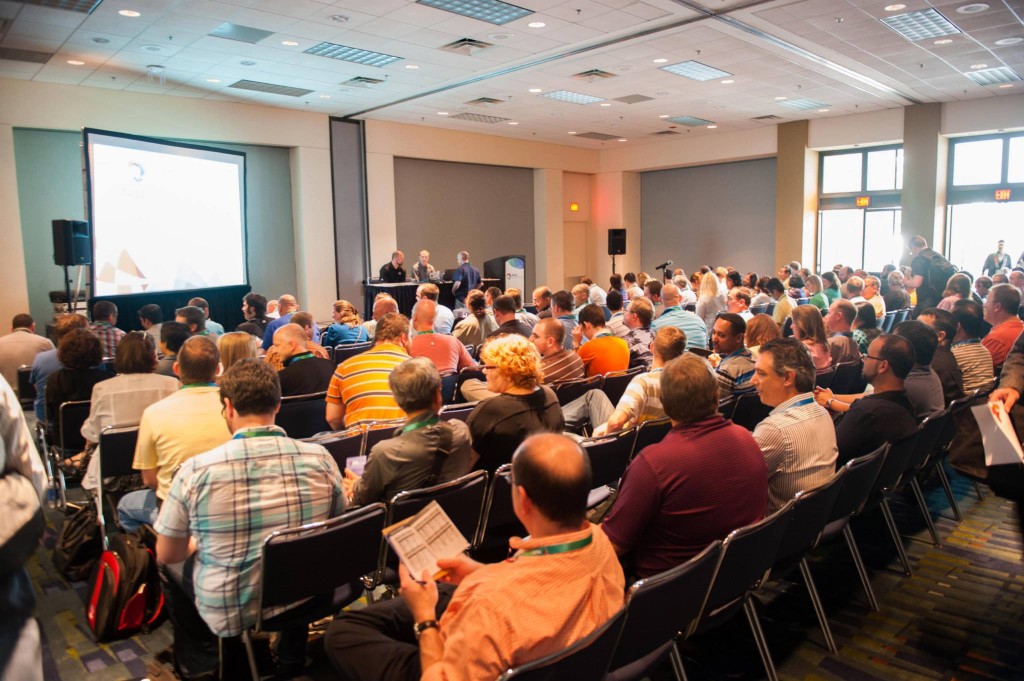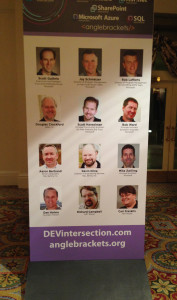I was recently chatting with the current President of PASS, Thomas LaRock (Twitter | Blog), and Pieter Vanhove (Twitter | Blog), a prominent SQL Server consultant and expert in Belgium, about how I go about building and presenting a full-day technical seminar. In the SQL Server world, we tend to call these “pre-cons”, as in pre-conference seminar, because they’re typically offered as paid add-ons occurring prior to a full technical conference. We call them that even when they come at the end of the conference and, heck, when there’s no conference at all.
Kevin and Kendal Van Dyke preparing to kick off a session at the PASS Summit 2013
Personally, I have developed and delivered six different pre-cons over the years. Four are purely technical and two are professional development oriented. I keep them up to date and deliver around six per year these days, though I’ve done as many as ten in a single year. (But that was because I had a daughter’s wedding to pay for. Shameless plug – HIRE ME to deliver one of these in house.)
The Foundation of a Good Pre-Con Seminar is a Good Topic
There are a ton of perennially favorite topics which, once you write the session, you’ll be able to present over and over again. One interesting technique to choose a good topic, if you’re not sure what you want to present, is to use Google Insight to see what are the most popular variations of a topic you feel strongly about. Here are some additional thoughts on choosing a topic:
1. The most popular topics are always focused on ‘help me do my current work better/faster/stronger’. Broad, but fundamental topics tend to draw bigger audiences than niche topics. However, some events have a large enough attendance that even niche topics will pack a room. And always remember that your event organizer’s goal is to pack the room, no matter how much they like you.
a. The biggest winners in my market are server troubleshooting & performance tuning (for DBAs) and various topics on better SQL coding (for devs). That’s why a session on performance tuning or coding best practices will bring in more attendees than, say, a session on features in the newest release or professional development. That’s sad for me, since I love leadership and career training and have a really good full day pre-con on the topic, but they never bring in more than 1/3 of what the biggest tech session brings in. And don’t forget – people love to hear about mistakes to avoid just as much as how to do things better. So “gotcha” topics can bring in just as many attendees as a best practices session.
b. Sessions that drill into a hot and hyped new technology tend to do really well too. So something like ‘Implementing Big Data with SQL Server’ can bring in a big crowd. But technologies that are too broad and ill-defined have the opposite effect on attendance. For example, many people still don’t “get” Azure or cloud computing in general. So, while it’s definitely a worthwhile topic, don’t be disappointed if you don’t put a butt in every seat.
c. Some pre-cons are feature-oriented, like Replication or Disaster Recovery. Many of these features are very cool, but are only available in SQL Server Enterprise Edition. For example, some of the Always On Availability Group features are EE only. Less people have Enterprise Edition than Standard Edition, so less people will come to an Enterprise Edition-oriented session. The features you plan to discuss will directly correlate to your attendance numbers. I’m telling you to avoid these topics, rather just expect it to have an impact in the size of your audience.
2. You will absolutely spend way too much time researching and developing your slide deck. So it’s also always good to choose a topic you want to learn more about. This’ll not only improve the attendees skills, but yours as well. Want to learn more about Hekaton? Then include it in your pre-con. Want to learn more about SQL Server query tuning? Write and deliver a session on it. You’ll learn it better than you ever would, independently, because you know you’ll get tough questions and you want to be prepared for those.
You Can Attract and ‘Manage’ Your Audience Through Your Abstract
This is the second most important step. You can’t control what your audience is like once they get into the room. But you can strongly influence who decides to come into the room in the first place with your session title and abstract.
Personally, I believe your title should immediately inform the reader of the topic and who is intended to reach, such as “Cutting Edge Debugging Techniques for the .NET Developer” or “Top 10 Mistakes New Tech Managers Make”. The title is alone constitutes 60-75% (by my careful, non-scientific assessment) of what will drive an attendee to your session. In fact, many attendees never even read the session abstract, unless there are two sessions at the same time that seem equally worth attending. In that case, the abstract is often the tie-breaker.
Be sure that your abstract explains not only what the session is about, but what the topic is and why people should care about it. I can’t tell you how many times I’ve seen a session abstract that names a specific, niche feature in the title but doesn’t tell what that feature is in the abstract. I once saw a session whose title was, and I paraphrase, “Introduction to the Flux Capacitor“. The abstract said I’d learn three cool was to use the flux capacitor and would see live demos of the flux capacitor in action. But it didn’t say what tool the flux capacitor was used in (.NET? BI? Java? SQL Server? SharePoint?), who would use it, what it did, or why it matter. And I always like to include at least three high-level topics the attendee will leave having learned.
Having said all of that, I feel like there’s no better write-up of how to write a top quality session abstracts that in the blog post by Adam Machanic (b | t) entitled “Capturing Attention: Writing Great Session Descriptions“. This is such a good overview of doing abstract writing the right way that I wish technical conferences would make this required reading for their speaker submissions. (Are you listening SQL Saturday?)
Planning and Building Your Presentation
A lot of accomplished speakers who’ve done one-hour sessions become both excited and terrified about doing a full 7- to 8-hour session. And one of the first fears that people share with me is that they won’t have enough to say or that they’ll be able to fill the time. Believe me – this will not be your problem. In fact, if you properly research your presentation and read what other writers and bloggers have to say, you will have difficulty fitting everything you want to talk about within your allotted time.
Here are some planning tips I use for planning and building my sessions:
1. I estimate that I’ll speak 3 minutes per slide. Then I do the math for how many slides I can fit into the amount time I have in the given session slot. For example, a 75 minute session should not have more than 20’ish slides, taking into account some time for the introductory and closing slides, questions, and demos.
2. Attendees are idiots AND geniuses simultaneously. One surprising thing I’ve learned after averaging about 6 pre-cons per year for the last few years is that no one reads the session-level advice (i.e. whether it’s a 200, 300, or 400 level session). They always read the titles, and possibly skim the abstract, and then make their decision based on that.
a. Here’s an important part tip for your presentation: you will definitely have plenty, maybe even a surprising number, of attendees who don’t know the basics of your topic. For example, in a recent pre-con called “50 Things Every SQL Developer Should Know“ that my buddy, Aaron Bertrand (b | t) and I presented at SQL Intersection, I now include a whole section discussing how the plan cache works and how to read execution plans. I clearly told attendees that they needed to know those things as prerequisites, but I’d say about 40-50% of the attendees in fact did not know the fundamentals.
b. At the same time: You will have attendees who are quite advanced. I try to identify those kinds of attendees early on (often by explicitly asking who has a lot of experience), then I try to include them as allies in the presentation. I ask their feedback a lot and give them a lot of eye contact. If there’s a question that seems tough, I might turn towards them and say “Have you ever seen that in your shop? How did you deal with it?” Usually, if they’re experienced and knowledgeable, then they love to share. It’s often as enjoyable for them to be recognized as smart as it would be to learn some big, new skill or technique. That helps keeps both ends of the talent spectrum equally happy.
3. Demos are the most stressful part of even one-hour sessions. It’s an order of magnitude worse in a day-long session. In my case, I strive for a high degree of deliberately assessed order and standardization:
a. Never install new software or change your configuration within 48 hours of your presentation. If some enterprise policy forces a change, assume the worst and retest all of your demos.
b. Include in the PPT notes panel the exact path and filename for a demo file that a particular slide relates to. It’s not as important if you recently wrote the slide deck. But it becomes very important if you wrote the session a while ago and no longer know all of the facts cold about your demos. For that matter, I’m now putting a number prefix on all of my SQL scripts so I can see which to load into SSMS in what order. Also, SSMS orders open tabs automatically. So numbering them works much better than giving only an alphabetic name.
c. If you’re running short on time, explain the concepts and tell where attendees can find the demo scripts, but skip the demos themselves.
d. One thing I’ve started to do, especially for really complex or annoying demos (e.g. a demo involving multiple servers such as a big Availability Group), is to either screenshot the whole demo process or make a video of the demo using Camtasia. Then I show the slides or the video instead of the real work environment. That way I can illustrate the principles involved without ever risking something going wrong. Attendees don’t seem to mind at all.
e. This is so axiomatic that I shouldn’t have to mention it, but just in case, create your demos in such a way that they require very little new typing. If you have to do more than change a parameter or two, then you need to work on your demos a bit more.
4. For goodness’ sake, get to the room as early as is practical and get comfortable with the learning environment. Expect problems with setup. Many laptops have issues with certain types of projects and require a lot of tinkering to get working properly. And carry spare equipment for crazy and unexpected issues. Batteries for your wireless mouse is practical, of course, but other mind-boggling things can happen. For example, I’ve spoken at many facilities which did not have an electrical outlet anywhere near the podium. My lesson learned? I always carry a 3m extension chord.
Making the Session Memorable
There are several small tips and tricks you can use to make sure your session is memorable and well-regarded. (And when you have well-regarded sessions, you get invited to do more session. It’s a positive feedback loop, engineers!) Here are some of my favorite techniques:
1. Work with a co-presenter. Personally, I love working with co-presenters. This might not be your cup of tea, since you have to split revenue, and I can respect that. But hear me out. On the one hand, the shared workload for both writing and presenting the pre-con is much easier. And don’t forget that most of us aren’t used to standing or speaking for 8-hrs straight. So being able to tag-team with another presenter off and on through the day can be like mana from heaven at times when you’re flagging. On the other hand, audiences find dialogue much more entertaining than monologue. Have you ever noticed that the morning radio show on your drive to work is no longer a single, lonely DJ? There is almost always at least two and sometimes as many as a half-dozen people on the “!!WKRP Morning Team!! Caffeinate your day!!” show, and sometimes even skits and almost-comedy bits. People just enjoy that format more and it translates into measurably ratings for the radio stations. It will for you too.
2. Quiz the attendees as you go along. You want people to remember your session and, even better, recommend it to others. One trick that I learned when I was trying to master recall of names is to repeat a person’s name back a time or two before the introduction concludes. You can use this tip, as a presenter, to help your attendees remember aspects of your session. After you’ve advanced the slide, find a reason to ask a question relevant to an earlier slide. In some cases, I’ve started to substitute old fashioned slide notes pages (i.e. a list of standard bullet points) for a quiz sheet, which is essential the same list of bullet points with a single key word as a fill-in-the-blank. The attendees will really get into making sure those blanks are filled it. If you miss one, they’ll make you go back and tell them what goes in the blank. (Hooray! They were paying attention!) Make it fun. Tease them jokingly if they forgot something you just talked about. But keep the attendees engaged and mindful of the major lessons.
3. Provide useful takeaways. Attendees love to be able to reference a list of takeaways. Just think about all the great sessions you have ever been to before. They usually have some level of detail for you to consume easily and walk away with or reference later. They have clean demo scripts with lots of comments that would stand on their own without slides or someone speaking. They offer the attendee the ability to be immersed in the “here and now” and the ability to come back for a summary to jog their memory. In my case, I actually have a password protected area of my website where attendees can download the slide decks and demo scripts to all of my pre-cons. My theory being that the attendee has paid for this training, so I want to provide an incentive for them to view me as one of the Go-To references going forward, to encourage them to attend other pre-cons of mine, and to nudge them to promote me to others.
Well, that’s my strategy for pulling off a successful and repeatable pre-con. Have you done a full day training session yourself? What sort of techniques have you learned to make your session more effective and memorable? Share your thoughts and questions here.
Many thanks,
-Kevin



Speak Your Mind